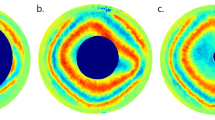Abstract
Using a micropolarographic system, the responses of seven human corneas to oxygen atmospheres ranging from 20.9% to 0% were measured. Under normal atmospheric conditions, ratios of oxygen demand were observed between corneas as great as 1.23:1. Following 0% oxygen conditions, however, these ratios rose to a maximum of 1.93:1, i.e., representing demand differences between particular corneas of nearly 2:1. Such differences may prove increasingly important in the gauging of patient suitability and safety in relation to hypoxic stress, e.g., the extended wear of contact lenses.
Similar content being viewed by others
References
Benjamin WJ (1982) Corneal physiology under the closed eyelid of humans. Ph D Dissertation, The Ohio State University, pp 21–24
Benjamin WJ, Hill RM (1985) Human cornea: oxygen uptake immediately following graded deprivation. Graefe's Arch Clin Exp Ophthalmol 223: 47–49
Benjamin WJ, Hill RM (1986) Human corneal oxygen demand: closed-lid factors. Invest Ophthalmol Vis Sci [ARVO Suppl] 26: 32
Efron N, Carney LG (1979) Oxygen levels beneath the closed eyelid. Invest Ophthalmol Vis Sci 18: 93–95
Hill RM, Fatt I (1963) Oxygen depletion of a limited reservoir by human conjunctiva. Nature 100: 1011–1012
Hill RM, Fatt I (1964) Oxygen deprivation of the cornea by contact lenses and lid closure. Am J Optom Physiol Opt 41: 678–687
Holden BA, Sweeney DF, Sanderson G (1984a) The minimum precorneal oxygen tension to avoid corneal edema. Invest Ophthalmol Vis Sci 25: 476–480
Holden BA, Mertz GW, McNally JJ (1984b) Corneal swelling response to contact lenses worn under extended wear conditions. Invest Ophthalmol Vis Sci 24: 216–218
Keppel G (1973) Design and analysis — a researcher's handbook. Prentice-Hall, Englewood Cliffs, New Jersey, pp 85–103; 465–466
Larke JR, Parrish ST, Wigham CG (1981) Apparent human corneal oxygen uptake rate. Am J Optom Physiol Opt 58: 803–805
Roscoe WR, Wilson GS (1984a) Equivalent oxygen percentage (EOP) technique: a standard calibration curve. Am J Optom Physiol Opt 61: 601–604
Roscoe WR, Wilson GS (1984b) Polarography: an oxygen survey correlating oxygen transmissivity to “EOP” values. Invest Ophthalmol Vis Sci 25: 1453–1454
SAS User's Guide: Statistics (1985) Version, 5 ed. SAS Institute, Cary, NC, USA, pp 470–476
Stocker EG, Schoessler JP (1985) Corneal endothelial polymegathism induced by PMMA contact lens wear. Invest Ophthalmol Vis Sci 26: 857–863
Author information
Authors and Affiliations
Rights and permissions
About this article
Cite this article
Benjamin, W.J., Hill, R.M. Human cornea: Individual responses to hypoxic environments. Graefe's Arch Clin Exp Ophthalmol 226, 45–48 (1988). https://doi.org/10.1007/BF02172717
Received:
Accepted:
Issue Date:
DOI: https://doi.org/10.1007/BF02172717




